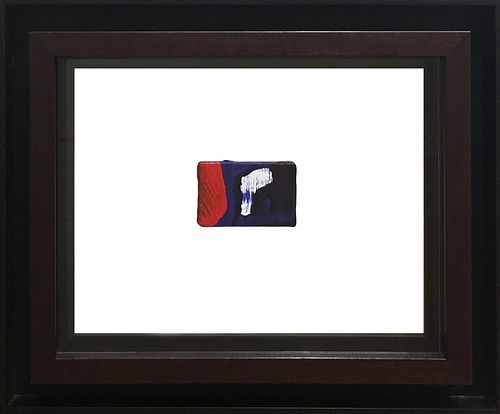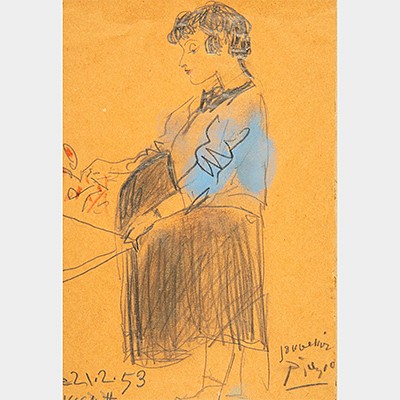SAM FRANCIS (San Mateo, California, 1923 - Santa Monica, California 1994). Untitled, 1984 (SFF.1099 aka SFP84-46). Acrylic on canvas. Signed on verso
Lot 63
About Seller
Setdart Auction House
Carrer Aragó 346
Barcelona
Spain
Setdart Subastas was born in 2004 and is currently the first online art auction in Spain with solidity, prestige and reliability guaranteed by our more than 60,000 users. Setdart has a young, dynamic and enterprising team ready to successfully manage the purchase and sale of art works through custom...Read more
Estimate:
EUR€17,000 - EUR€19,000
$18,478.26 - $20,652.17
Absentee vs Live bid
Two ways to bid:
- Leave a max absentee bid and the platform will bid on your behalf up to your maximum bid during the live auction.
- Bid live during the auction and your bids will be submitted real-time to the auctioneer.
Bid Increments
| Price | Bid Increment |
|---|---|
| EUR€0 | EUR€10 |
| EUR€200 | EUR€25 |
| EUR€500 | EUR€50 |
| EUR€1,000 | EUR€100 |
| EUR€3,000 | EUR€200 |
| EUR€5,000 | EUR€500 |
| EUR€10,000 | EUR€1,000 |
| EUR€20,000 | EUR€2,000 |
| EUR€50,000 | EUR€5,000 |
About Auction
By Setdart Auction House
Sep 20, 2021
Set Reminder
2021-09-20 08:00:00
2021-09-20 08:00:00
America/New_York
Bidsquare
Bidsquare : CONTEMPORARY ART
https://www.bidsquare.com/auctions/setdart-auction-house/contemporary-art-7482
Setdart Auction House sofia@setdart.com
Setdart Auction House sofia@setdart.com
- Lot Description
SAM FRANCIS (San Mateo, California, 1923 - Santa Monica, California 1994). Untitled, 1984 (SFF.1099 aka SFP84-46). Acrylic on canvas. Signed on verso in cursive by the artist: 'Sam Francis' with inscriptions 'SFP84-45' in blue marker and 1984 in grey pencil. Provenance: -Nantenshi Gallery, Tokyo (1985). -Private collection, Japan. Attached certificate of authenticity issued by the Sam Francis Foundation. Listed in the catalogue raisonné under no. SFF. 1099. Measurements: 5,08 x 7,62 cm. In this canvas San Francis presents us with a composition devoted to the study of rhythm and the linear decomposition of abstract forms. Styles such as neoplasticism and constructivism have been assimilated in a personal way; however, the Californian goes further and breaks with this idea of pure lines, leaving spaces to chance and to the expressiveness of the pictorial material itself, as can be seen in the spilled drops of the painting. San Francis studied botany, medicine and psychology at Berkeley University in California between 1941 and 1943, and served in the United States Air Force during the Second World War from 1943 to 1945 before being injured in a plane crash. He spent several years in hospital, and it was during this time that he began to paint, at the urging of his friend David Parks, a professor at the San Francisco School of Fine Arts. Once out of hospital he returned to Berkeley, this time to study art. His studies in painting and art history took him from 1948 to 1950. Francis' early work is directly influenced by the Abstract Expressionists such as Rothko, Gorky and Still. During the 1950s he lived in Paris, where he held his first solo exhibition in 1952 at the Galerie Nida Dausset. During the fifties and sixties he held important solo exhibitions and participated in group shows at the Ribe Droite (Paris, 1955), Martha Jackson (New York, 1956), Gimpel Fils (London, 1957), the exhibition "New American Painting", which toured eight European cities (1958), the Documenta in Kassel (1959 and 1964) and the Kunsthalle in Bern and Düsseldorf. In 1963 he settled in Santa Monica, California, and six years later he was awarded an honorary doctorate by the University of Berkeley. It was during this period, between 1960 and 1963, that he created several series of works, including the "Blue Balls" series. Consisting of predominantly biomorphic blue shapes and drops, these works referenced the pain resulting from the kidney tuberculosis he suffered in 1961. He continued to paint, mainly in Los Angeles, but also in Tokyo, where he lived mainly in 1973-4. In 1965 Francis began a series of paintings featuring large areas of open canvas, minimal colour and strong lines. His work evolved further after he began an intense Jungian analysis with Dr. James Kirsch in 1971. It was then that he began to pay close attention to his dreams and the unconscious images they suggested, Francis's works from the early 1970s have been called fresh air images. Created by adding pools, drips and splashes of colour to wet bands of paint applied with a roller, these works reaffirmed the artist's interest in colour. By 1973-4, many of Francis's paintings featured a formal grid or matrix composed of cross-hatched traces of colour. Many of these matrix works were large in scale, measuring up to twenty feet long.After 1980, the formal grid structure gradually disappeared from Francis's work. He was extremely active as a printmaker, creating numerous etchings, lithographs and monotypes, many of which were executed in Santa Monica at Francis' own Litho Shop.In 1984 Francis founded The Lapis Press with the aim of producing unusual and timely texts in visually appealing formats.
- Shipping Info
-
In-house shipping available. Please inquire at admin@setdart.com.
-
- Buyer's Premium



 EUR
EUR CAD
CAD AUD
AUD GBP
GBP MXN
MXN HKD
HKD CNY
CNY MYR
MYR SEK
SEK SGD
SGD CHF
CHF THB
THB













